|
I visited Dayton Air Show on July 28 and 29. Dayton, OH was the
place where Wright Brothers were born. Now, the center research
facility of U.S. Air Force, Wright Patterson AFB, is located in Dayton.
One of the three biggest (I believe) air museums of the U.S. - U.S. Air
Force Museum - is located right next to the Wright Patterson AFB.
So, Dayton has been a city of aviation, and Dayton Air Show has been
a very large air show, except last year. I don't know what
happened last year. But, it was a significant scale back from the
past air shows. The flight demonstration did not start until 1pm.
No excitement in the morning. I seriously thought about not coming
this year.
However, they resumed the previous level this year. Except one
sad happening. I'll describe it below.
The first day. The ceiling was low in the morning. No
vertical maneuvers was possible. But, in such circumstance, AV-8B
Harrier was what we needed. An AV-8B Harrier showed V/STOL and
hovering demonstration.
Next came Jim Leroy's "Bulldog". I was not particularly a fan
of Jim Leroy. So, I was just watching his aerobatics without
taking pictures. But, later I strongly regretted about not taking
his pictures during this aerobatic flight.
The main performance of the morning session was Brazilian Air Force's
aerobatic team "Smoke Squadron." It consisted of seven prop
airplanes. They were quiet obviously because they didn't have
afterburners. Nonetheless, their skill was outstanding.
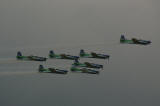 |
 |
| First
fly by. Looked like an arrowhead formation. I don't
remember what it was called exactly. |
Final
pass of the day. 3-by-3 back-to-back formation. |
There are some civilian aerobatic teams that have 4 to 6 airplanes.
However, probably due to the limitation of training time, few of them
can fly a really stable formation. Usually, some of the airplanes
in the formation go up and down, left and right. In contrast, the
Smoke Squadron flew really stable formations. Their airplanes
looked as if they were connected by invisible bars. Despite lack
of vertical maneuvers due to low ceiling, their aerobatic flights were
very impressive.
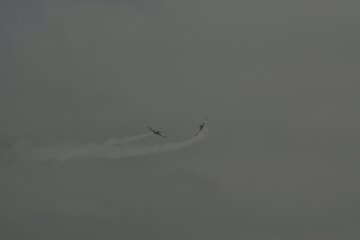 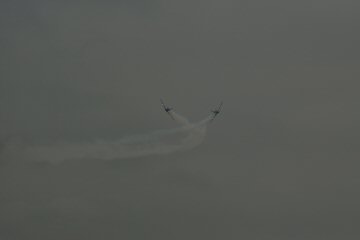 |
| Double cross by
Smoke Squadron. |
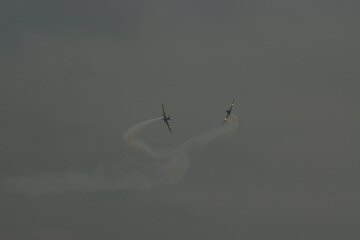 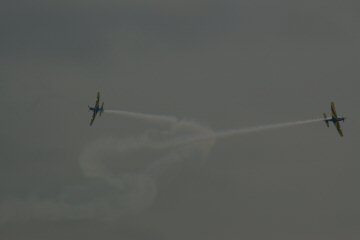 |
| The second cross
after the first cross. |
Then AV-8B demonstrated V/STOL demo once again, and B-2 and F-117A
flew by.
 |
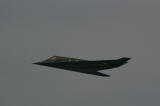 |
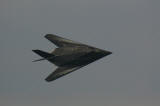 |
|
Fly by of B-2. Due to high
humidity, vapor was visible over the wings. |
Fly by of F-117A. |
F-117A dedication pass! I saw
F-117A trailing vapor for the first time. It was a good photo
opportunity! |
F-4G flew next. This F-4G Phantom II was maintained by a
museum. Nowadays, we cannot see a flyable F-4G often, and it was a
rare opportunity for me to take pictures of F-4G in the air.
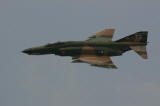 |
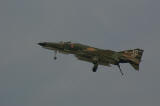 |
|
F-4G's dedication pass. |
F-4G in landing configuration. |
Then a CV-22 showed a demonstration. And, a civilian team of
Jim Leroy and Skip Stewart were supposed to perform before Thunderbirds.
It was Jim Leroy's second flight of the day. I was not
particularly a fan of Jim Leroy. Nonetheless, their skills were
outstanding. They flip an airplane, keep 90-degree bank, and all
those rapid and complex maneuvers at an altitude where I round out and
flare for landing with full of my concentration. If I make a small
mistake at that moment, I just end up with making a hard landing and
thank my landing gears for absorbing the shock. However, a small
mistake means an immediate death for them. They do such
no-room-of-mistake maneuvers as if they were easy. They look easy
because the pilot has an outstanding flying skill, and the maneuvers are
indeed dangerous.
Jim Leroy and Skip Stewart took off from the opposite directions.
They pulled up and made a half loop. At the top of the loop, both
of them entered spin. They were supposed to recover just before
hitting the ground and come back up. However, Jim Leroy did not
climb. I felt he was late to come back up, when I heard on the
radio someone shouting "Discontinue! Discontinue!" That was the
moment he crashed. Some moment later, black smoke was drifting up
from the point of crash. Probably, about a minute had passed after
the crash before the black smoke was visible. I felt firefighters
did not come soon enough. Later they announced that firefighters
started action within one minute of the crash. I don't believe it.
They started shooting water maybe within one minutes after the black
smoke started drifting up. But, certainly, more than one minute
had passed after the crash before firefighters came. Maybe it
depends on the definition of the "action." What they meant may
have been they started the engine of their truck and started moving
toward the crash scene within one minute of the crash. Jim Leroy
died in an Army Blackhawk helicopter on the way to the hospital. I
probably have visited air shows more than hundred times. But, it
was my first time to see a crash in front of my eyes.
I know their flying is totally different from my flying. My
steep turn is 45-degree bank while 90-degree bank is nothing unusual for
them. I never practice stall recovery lower than 1,500ft AGL while
they recover from a spin just before hitting the ground.
Nonetheless, seeing a very experienced pilot dying in front of my eyes
gave me a bitter feeling of loss of a colleague.
Thunderbirds' flight was subsequently cancelled for the obvious
reason.
The second day. They respected the ticket of the first day.
So, I could enter the air show area without buying a new ticket.
At first, the ceiling was even lower than the first day, but the clouds
quickly burnt off. The crowd was sparser on the second day, maybe
due to the accident or due to the weather. In fact, one of the
pilots of two F-16s of Ohio National Guard who did low approach before
the weather recovers said on the radio "I don't see many people there."
So, he didn't see many people from the air. When the weather
recovered, F-18 and F-4U Corsair did a heritage flight, followed by F-18
aerobatics.
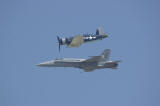 |
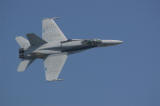 |
|
Heritage flight by Marine Co. F-18C
and F-4U Corsair |
F-18C's dedication pass. |
Brazilian air force's Smoke Squadron flew at the end of the morning
session. Unlike the day before, they showed all maneuvers
including vertical maneuvers with the clear blue background.
 |
 |
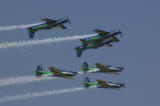 |
|
Delta formation. |
Something like two-airplane version
of double-farvel roll |
3-3 back-to-back |
The afternoon session was all good, too. Here are some pictures
from the afternoon session.
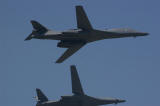 |
 |
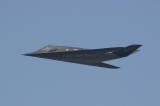 |
|
Two B-1B bombers |
Sort of Dedication pass. It
cannot take a too-deep bank because it's a bomber. |
F-117A fly-by. |
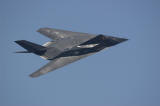 |
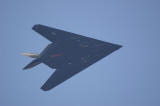 |
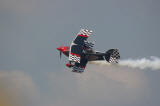 |
|
I aimed with a little longer zoom
this time, and it came out well. |
Bottom side of F-117A. |
Skip Stewart. He was supposed
to fly with Jim LeRoy. He overcame the shock of Jim's
accident, and showed stunning aerobatics. |
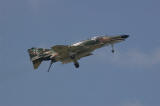 |
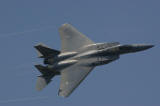 |
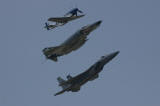 |
|
I also tried to take a nice shot of
F-4G's dedication pass. However, my camera chose F9.5, which
yielded 1/750 sec shutter speed, resulting a blurry picture. I
should have used Av mode with F8 or F6.4 setting. I shouldn't
have trusted my camera's moving object mode.... |
F-15's dedication pass. This
one came very well. |
Heritage flight of P-51, F-4G, and
F-15. |
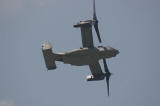 |
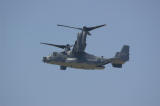 |
|
|
CV-22 in airplane mode |
CV-22 in helicopter mode |
|
Thunderbirds performed a high show with all maneuvers. Their
aerobatics were spectacular as always!
 |
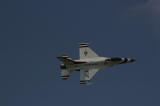 |
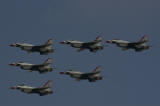 |
|
It's nothing-special. I have
taken this picture many times, but this time I took it again to
compare with *ist DS2. |
I kept failing to take a good shot of
Surprise-Pass because I was using a too-long zoom. So, this
time I chose 200mm zoom, which was too short. It's so
difficult to choose an appropriate focal length for this one....
Next time I'll try 230 to 250mm. |
Thunderbirds Delta. I liked
this picture because all six pilots are |
|
